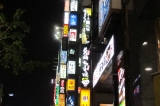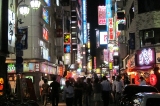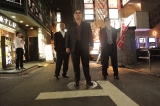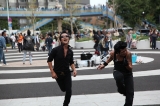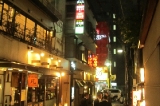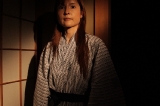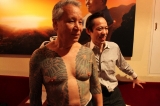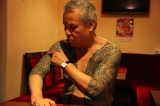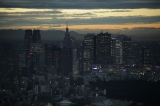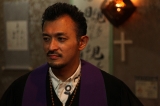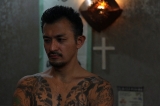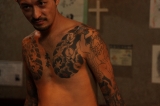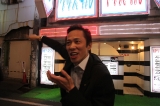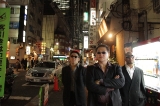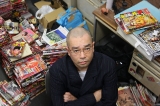[tab:Videos]
Crime Lords Of Tokyo – Preview Video
Nat Geo Investigates Video – Marked For Life
Nat Geo Investigates Video – Japanese Mobsters
Behind The Scenes Footage
[tab:Photos]
Production Photos
[tab:About]
Tokyo. Orderly…modern…and seemingly safe. But this vast neon city hides a dark
secret. For the millions who live here, it’s something you don’t see every day,
and you may never encounter it face to face. For people on the inside, however,
nothing could be more obvious than the power of Japan’s infamous organized crime
syndicates known as the yakuza. This evocative and groundbreaking documentary
takes you inside this secretive underworld to meet the real yakuza, thugs and
high-ranking bosses, plus the people who write about their every move, and the
cops who track them down.
Author Shoko Tendo grew up inside a yakuza family, the daughter of a crime
boss. She recalls haunting episodes from her youth—her father breaking up the
house in a rage, a young man presenting his severed pinkie finger as a token
of his remorse. Shoko thought she could live in this world, until the day it
all went bad. Her decision to leave it behind would push her to the edge, where
she found strength in an unexpected place. For Tatsuya Shindo, losing his finger
to appease an angry boss was only the start of his troubles. For this young
foot soldier, a war for his soul was beginning, one that pitted his yakuza boss
against the God he longed to serve. Who would win his loyalty?
Incredible personal stories and candid interviews with people on the inside
reveal an organization both honorable and corrupt, violent and restrained, compassionate and driven by an insatiable greed. Japan’s national police are cracking down through raids and arrests, new anti-organized crime laws and public relations campaigns. But the yakuza seem to evolve to meet every new challenge that comes their way. In the red-light district, they are as obvious as the neon signs luring tourists into nightclubs and bars, places were anything can be had for the right price.
Here, a top yakuza boss, Mitsunori Agata, invites our cameras inside this dangerous underworld. He tells his unforgettable personal story, and explains why the
yakuza will never disappear from Japan. This amazing journey combines real-life stories with cinematic recreations to create a compelling portrait of Japan’s
most infamous criminals—the real face of the yakuza.
[tab:Blogs]
Crime Lords Of Tokyo
Blog by Philip J Day – Director/Producer/Writer
The first time I saw Shoko Tendo I was startled at how frail and thin she looked. We had arranged to meet her at a nice hotel in Ikebukuro, an expensive commercial area of the vast Tokyo metropolis. It was the last shooting day. And I really needed a great story if our film was to work.
We had been in Japan’s capital for three weeks trying to investigate one of the biggest, yet most secretive, organized crime groups in the world; the yakuza. The Japanese mafia, numbering over 80,000 members, is notorious for full body tattoos and missing fingers. They are also known to be extremely violent. So, it’s no surprise that very few Japanese are prepared to speak about them, particularly on camera and especially to a foreign film crew. But that’s exactly what Shoko Tendo had agreed to do for us. And what a story she had to tell.
Our translator, Chako, greeted Shoko in the lobby and introduced us to her. As we traveled up in the elevator Chako made small talk but Shoko seemed detached and I worried that she didn’t want to be there. How wrong I was! To record the interview we had booked a beautiful traditional Japanese tearoom on the fourth floor. Low tables, adorned with intricate artifacts, stood on tatami mats, which were spread across the floor. We had pre-lit the interview but as we were running a little late we asked Shoko if she minded that we got straight on with it. Without blinking or moving any facial muscles she nodded in agreement.
What first surprised me was how much the camera loved her. While in real life she seemed incredibly frail, almost brittle, but on camera she seemed angelic, poised and beautiful. But looking pretty wasn’t why we were there. It was her life story that was tragically fascinating because this young woman had been through so much at the hands of the notorious yakuza.
Over the course of an intense hour she told us about her father who was a crime lord. Her early years were strange but the family enjoyed luxurious times. Then, by her mid-teens, her father fell behind on payments and she was pressured by a gangster to pay off the family debt by becoming his mistress. She eventually escaped from him, only to end up with another boyfriend who beat her regularly and severely. But when she got pregnant it turned out to be the best thing that could have happened and from the moment her child was born, she managed to transform her life. She wrote a best-selling memoir about her terrible exploits.
Spellbound, we got to the end of the interview and I for one was tearful for the journey she’d just taken us on. But now the most difficult thing of all. We knew that as a response to years of abuse that she had decided to be tattooed just like male yakuza, which meant her entire body. We had to ask to see and film her tattoos.
Our translator talked her through what we needed but surprisingly she agreed without hesitation. She told Chako that she wanted to give us her full story and that the tattoos were part of that story. So, with her back to the camera she slowly removed her gown, revealing one of the most intricate tattoos I had ever seen. In the center of her back there was an incredible image of a woman with a dagger gripped in her mouth. I asked what that represented. Without blinking Shoko looked straight at me and through the translator she said, “It is called the Prostitute from Hell”. At that moment I knew that this image and Shoko’s interview would become the centerpiece of the film. It was an extraordinary end to a truly moving story.
Yakuza Web Blog
By Calder Greenwood – Co-Director
During our search for real-life yakuza members to interview, we were informed
of an ex-yakuza turned pastor, who ran a Pentecostal church in Saitama, just
outside of Tokyo. The church was a renovated bar called the June Bride, owned
by his mother. We took a few trains and a taxi to leave the city proper, noticing
the lights and sounds got less intense the farther away we traveled. June Bride
was located on the corner of a quiet street, and only the faint organ sounds
coming from inside suggested it was anything other than a bar. We met Tatsuya
Shindo, the pastor, and witnessed a wedding ceremony scheduled for that night.
He seemed a capable and sincere preacher, and held the room’s attention for
the sermon. It wasn’t until after the ceremony that he showed us his traditional
irezumi tattoos and severed pinkie finger, cut off in penance to his oyabun
(boss) for a mistake made while still a yakuza. He was sent to prison, and while
inside found God, and the rest is history.
After the interview he joined us for dinner at a restaurant across the street,
during which we explained in greater detail the nature of our documentary. He
mentioned he knew yakuza – friends from childhood who remained in the faction
– who might be willing to meet us. Within five minutes of making a phone call
they arrived, living only a few blocks away. The second the shoji door to our
private room slid open, you could feel the presence of these men. There was
a palpable sense not of danger, but of respect. The way one might look away
from the gaze of a wild animal when there’s no fence to ensure your safety.
As they walked in they immediately became the alpha dogs, and we all bowed to
show our respect. Since Shindo had known them for so long, his casual relationship
with them helped to ease the tension in the room, and drinks were quickly poured.
Shindo explained who we were and what we were doing in Saitama, and as it turned
out they were familiar with the National Geographic Channel, and often watched
it in their yakuza office.
Within 30 minutes we were already conducting a private interview in the next
room over, in which both men opened up about their experiences from the inside,
and showed us their tattoos. When the interviews were over, as it was too late
to catch a train back to Tokyo, they called a taxi for us and personally saw
us off. The hour-long ride back was one in which we all marveled at the situation
we managed to find ourselves in that day, as it was our first encounter with
real-life yakuza. But it wasn’t to be our last…
Yakuza Web Blogs
By: Aaron Even – Writer
“I’m sorry, I can’t speak on the record.”
This was the comment made over and over again when we attempted to broach the
subject of the yakuza’s involvement in the world of high finance. It’s apparently
a deep involvement, and one I was interested in exploring as we sailed over
the Pacific Ocean at thirty thousand feet. But on the ground in Tokyo, it quickly
became clear that this wasn’t going to be an easy task.
The truth about the yakuza is that the image we have of them—thuggish swagger,
tattoos, funny hairdos—no longer matches the reality very well. As one financial
expert told me, there are really two different types of yakuza in today’s Japan.
The low-level bruisers and extortionists are the bottom of the barrel. They’re
an annoyance perhaps, but ultimately inconsequential. The real threat comes
from what this expert called, “the Abramovich yakuza” (a reference to Russian
billionaire Roman Abramovich ), sophisticated, intellectual types who understand
the world of stock markets and multinational corporations.
The yakuza are no fools: they go where the money is. It’s ultimately a simple
proposition that is familiar to virtually every modern business—what’s best
for your bottom line? Is it more profitable to control street-level prostitution
or run a chain of internet pornography websites? Do you make more from extorting
corner bars or defrauding major corporations and banks? To give a few examples
of this recent evolution in the yakuza’s “corporate strategy,” last year several
companies were delisted from Japan’s stock markets due to alleged involvement
with the yakuza. Major financial institutions and banks have gone broke after
being looted by yakuza predators, which often operate from the inside.
So what kind of money are we talking about? In all, this financial expert estimates
the two biggest yakuza syndicates, Yamaguchi-gumi and Sumiyoshi-kai, to have
assets worth $100 billion. And that’s just a ballpark figure.
If such numbers are correct, clearly that’s a major concern for millions of
investors around the world. For executives, it’s got to be a nightmare. Not
only could you wake up to find your company has been defrauded by some shady
yakuza-run scheme, but if you’re unlucky enough you may experience the bribery
or blackmail that often enough leads to suicides in Japan.
That particular point was driven home numerous times during interviews. There
are suicides, and there are “suicides”—the ones no one believes in, that are
too convenient, or that prevent some public exposure of private wrongdoing.
Scary stuff, if you happen to be a target.
So if all that’s true, why isn’t it a major part of our show? Ultimately the
answer is found in the first line of this blog. When no one wants to speak on
the record, it becomes very difficult for us as filmmakers to tell that particular
story. Facts become hard to verify. And even harder to portray in a visual medium.
On top of that, the sheer complexity of yakuza financial schemes makes them
challenging to understand, much less convey in a matter of minutes. So in the
end, although it makes for fascinating reading, it didn’t translate to the screen.
That’s too bad, in a way, because it’s an important truth about the yakuza that
deserves more attention. However, my hope is that if you’re interested in this
show, you’ll pick up a book or read an article or two, and begin to learn just
how far-ranging and fascinating Japan’s world of organized crime really is.
Crime Lords Of Tokyo
Blog by Philip J Day – Director/Producer/Writer
I owe a lot to Mr. Lee! Without his bravery I doubt we would have had such an interesting story to tell. Let me explain.
In September 2010, I was in Tokyo with a small crew making a documentary for National Geographic about the Japanese mafia known as the yakuza. With over 80,000 members it is one of the largest organized crime groups in the world. We have read that extortion is their typical source of income and that no one in Japan is immune from this “protection” racket. But while it seems most Japanese know about the yakuza few are prepared to discuss them.
We only had three weeks to get inside this secretive and dangerous world. So, we cast our net wide. Through a contact, I heard about a Chinese restaurant owner in Tokyo’s red light area who had talked on record about having to pay protection money to the yakuza.
I had our translator contact him and the next night we traveled to meet him at his restaurant in Tokyo’s red light district called Kabukicho. This bizarre world of neon and erotica sees Barbie doll-types tout for business outside garishly lit clubs where foreigners often aren’t allowed. Men in black suits and sharp haircuts stand guard, looking menacing to all who pass by. We are told many of them are yakuza. It makes me slightly nervous to walk among such overt displays of criminal activity, especially as we are there to look inside their world.
Xiao Mu Lee’s restaurant was on the fourth floor of a typically narrow building, where the tiny elevator can barely fit two of us. We enter a world of loud noise, smoke and rushing waiters they squeeze past us carrying trays of exotic dishes, beer and sake. Two Chinese chefs prepare Asian food in deep woks – flames and steam bellows from their tiny kitchen. The clientele is mainly Asian businessmen and the owner seems to know them all.
We meet Mr. Lee, who is slim, good looking, with a broad smile. The chain-smoking, flamboyant 50-year-old tells us he was a professional ballet dancer in Beijing before coming to Tokyo to open a restaurant 20 years ago. He has written 15 novels, which he shows us in a cabinet adorned with books and photographs of him. We tell him who we are and that we’re looking for a genuine insight into the yakuza. He tells us he has much to tell us but tonight he is busy, so to come back the following evening with our cameras. Before we leave I notice that he is talking to two heavy set looking guys – after a few moments he hands them an envelope – which the older one pockets, they bow and leave the building ahead of us.
The next night, and somewhat anxiously, we return with our cameras. Mr. Lee tells us some incredible inside secrets about how the yakuza operate, how they keep from being busted by the cops and how they extort money from local businesses like his own. Members of the local yakuza drop by once a month to accept a “donation” for “protection.” Once, several years earlier, Mr. Lee tells us he was kidnapped and beaten by gang members for a “misunderstanding.”
I ask Mr. Lee if he is worried about telling us these things on camera. He assures that he has a good relationship with the yakuza and as long as he plays by the rules of mentioning no names he will be “protected.” Not only does Mr. Lee give us an astonishing interview but over the next few days he will introduce us to a host of characters, including a yakuza boss, who transform our investigation from an academic study to being a genuine inside look at this most secretive world. Like I said, I owe a lot to Mr. Lee.
Crime Lords Of Tokyo
Blog by Philip J Day – Director/Producer/Writer
The flamboyant Chinese restaurant owner, Mr. Lee, tells me he is not afraid of the yakuza. But I ask him does he feel comfortable to be seen on T.V. saying negative things about the notorious gangsters? As way of confirmation he signs our release documents without hesitation. He also tells me that he will try to get us an interview with a real yakuza boss. To be honest, I don’t really believe him but I am certainly prepared to give it a try.
The next day we arrive at the restaurant to that find Mr. Lee has been entertaining a large group of Chinese clients and seems to have enjoyed the celebrations himself. We wait for him to finish with his clients but I fear that the promised yakuza boss introduction is unlikely to materialize. Finally, he says his goodbyes to his clients and turns his attentions to us. Surprisingly, he says he wants us to film him giving us a guided tour of the red light area – Kabukicho – a place notorious for yakuza gangs.
Mr. Lee tells me it’s his neighborhood and that we shouldn’t be afraid. Somewhat apprehensively, I agree. For the next half hour we follow the eccentric and often hilarious Mr. Lee as he careens from shop to restaurant to sex-club, telling us that this restaurant pays extortion money, that this shop sells illegal sex, and that this group of men are all yakuza. He seems fearless, and some might say, reckless. Although it makes for a remarkable scene on camera, I wonder if it will get us all into trouble.
At the end of his tour of the narrow neon lit streets we arrive at a small insignificant restaurant. As we follow Mr. Lee inside with our cameras still rolling a thick set man in his fifties immediately stands up and urgently signals us to stop filming, which we do. It turns out that he is a bodyguard and that the neat, quiet gentleman sitting next to him is none other than the vice president of one of the main yakuza gangs. Not only is he perfectly charming but he also agrees to be interviewed on camera. Incredibly, Mr. Lee has been good to his word. We pile into two cabs and 15 minutes later we are back at Mr. Lee’s restaurant interviewing this powerful yakuza leader.
The boss gives us an incredibly open interview. He answers every question and tells us he has nothing to hide, including his identity. The trim 70-year-old tells us about his childhood; why he joined the yakuza, and the strict code that every member must live by. It is called gokudo and commits each member to a lifelong service. At the end of our questions he even strips off his jacket and shirt to show us his full-body tattoo. The work is quite incredible. He tells us he has followed a life of strict discipline, no alcohol and the regular practice of kendo. Even at this age he is clearly not to be messed with.
Finally I broach the sensitive subject of signing our release form. Nervously I hand him the document, which is written in both English and Japanese. Without hesitation he pulls out a pen from his expensive jacket and signs his name, puts down his contact details and gives his business card. Then without further ado he bows to each of us and, together with his bodyguard, he disappears into the night.
My crew and I look at each other in total awe of what has just taken place. This was the gold ribbon interview that we had come to find, and one of key elements that, I think, makes this documentary a fascinating insight into a dark, shadowy and strictly disciplined world.
[tab:Credits]
EXPLORER: Gangland Tokyo
Producer
PHILIP J. DAY
Directors
PHILIP J. DAY
CALDER GREENWOOD
Writers
PHILIP J. DAY
AARON EVEN
Editor
AARON MCADAMS
Directors of Photography
ROBIN PROBYN
KRIS DENTON
PHILIP J. DAY
CALDER GREENWOOD
COLIN HARGRAVES
Original Music
CHRISTOPHER RIFE
Narrator
J.V. MARTIN
Production Coordinator, Edge West
ERIN SHULSINGER
First Assistant Director
JEREMY GILBREATH
Second Assistant Director
J.P. OUELLETTE
DYLAN MATLOCK
Production Designer
CLARE BROWN
Art Director
FRANK BOLLINGER
Lead Man
DONNIE BIGGS
Set Decorators
PATRICK NUGENT
Art Swing
BRIAN SKALA
Property Master
SAMO TUSAK
Scenic Painter
SARAH COOK
Art Department Intern
VACLAV HAVLIK
Sound Recordists
SHINICHI MORISHITA
STEVE YASUI
MICHAEL KOMAGATA
Costume Designer
TAMMIE MARIE HICKS
Wardrobe Supervisor
AMBER LYNN
Set Costumes
JENNIFER HOUSLEY
Key Makeup Artist
LORRAINE MARTIN
Assistant Hair and Makeup
LAUREN ENSDORF
Assistant Camera
TYLER HARRISON
Still Photographers
MICHAEL JACOBSON
DESIREE STONE
Chief Lighting Technician
ED JOYCE
Best Boy Electric
JASON NORMAN
Electrician
IGOR TOCHILNIKOV
Key Grip
CASEY SLADE
Grips
YOSHI ISOMURA
OMAR PENA
JASON MCCANN
Casting Director
J.P. OUELLETTE
Actors
RUKA NAGASHIMA
MATTHEW LOCKERBY
GIANCARLO SOTTO
STEPHANIE YOON
JACOB YOON
JASMIN CURRE
ALICE WEN
CARY YOSHIO MIZOBE
LISA YAMADA
TERUMI SHIMAZU
MIDORI OKADA
GEORGE CHENG
CYNDEE SAN LUIS
LEAH PARK
ALPHA TAKAHASHI
MASAMI KOSAKA
JOSHUA SHIBATA
MARCUS NATIVIDAD
PETER MAI
DOUG WENG
TAKAHIRO FUKUDA
HY MIZUTANI
JOE BLATCHFORD
BENJAMIN KIM
DIANNE QUIRANTE
WESTLEY LE NGUYEN
BRIAN IKEDA
BRIAN FONG
WAYMOND LEE
CHON LEE
RUSSELL LE
JOHN PAUL ROMEO
BILLY WONG
KENNY KNOLL
Shinichiro Shimizu
Ralph Chan
TJ Maeda
Osamu Saito
Douglas Hachiya
Christian Mikkelson
Jim Chang
FUMI KITAHARA
CARY ALAN
NICK EPSTEIN
DANA J. STROM
KELLI GRIGGS
Transportation Captain
JIM KOSHAK
Drivers
DANIEL STOILOV
MIKE RENO
Post Production Supervisor, Edge West
DANA J. STROM
Fixer, Japan
CHAKO BELLAMY
Translator
MASAYO SODEYAMA
Key Production Assistant
COURTNEY KELLY
Key Set Production Assistant
MARLON “GOOSE” WALL
Production Assistants
LISA KATAYAMA
SABINE BRINK
CHRISTIAN MIKKELSON
KELLY RYAN
KATIE KEARNEY
Stage Manager
RALPH LLITERAS
Post Production Assistant
KELLI GRIGGS
Production Controller
MELISSA M. QUEVEDO
Production Accountants
KATIE GREENFIELD
COLLEEN WONG
Online Editor
JENNIFER MACFARLANE
Colorist
MATT LEAR
Sound Mixer / Sound Designer
JEREMY SOHL
Catering
BULLS-EYE CATERING
Main Title Design
NGT ART & ANIMATION
PIXELDUST STUDIOS
Visual Effects Supervisor
CALDER GREENWOOD
For National Geographic Television
Production Coordinators
DANYA HAKEEM
BILL GABLER
Senior Researcher
JOHNNA L. FLAHIVE
Director, Research
TODD HERMANN
Production Coordinator, Explorer & Specials
ANNA DERRYBERRY
Specialist, Production Rights & Clearances
KATIE LEE
Manager, Production Rights & Clearances
MARLENE WALKER-GOLDEN
Post Production Supervisor
DEBBIE NATHANSON
Post Production Coordinator
MINSEOK CHO
Specialist, Facilities & Scheduling
SARAH ELLISON
Manager, Post Production & MediaCore Scheduling
MARCIE CALLAHAN
Director, Post Production Operations
BRADEN MCILVAINE
Director, Production Rights & Clearances
CATHERINE YELLOZ
Director, Production Operations
ROSEANNE LOPOPOLO
Line Producer, Explorer & Specials
HILARY BURKE
Senior Producer
MAX SALOMON
Executive Producer
ROBERT ZAKIN
Senior Executive Producer, Explorer & Specials
JONATHAN HALPERIN
Vice President, Specials Development
MALVINA MARTIN
Senior Vice President, Business Development & Operations
DEBBIE LONDON-HARRINGTON
Senior Vice President, Standards & Practices
SCOTT WYERMAN
Executive Vice President, Production
KATHY DAVIDOV
Executive Vice President, Development
MARYANNE CULPEPPER
President, NGT
MICHAEL ROSENFELD
Special Thanks
*NATIONAL POLICE AGENCY (KEISATSU-CHO), JAPAN
*RITZ CARLTON, TOKYO
*LINDA BELTRAN
*MALUGO CO., LTD.
*MASAYO SODEYAMA
*MIURA COMPANY LTD.
*BRETT BULL
*MITCH MURATA
*MALIK KUSTERS
*FILM L.A., INC.
*THE CITY OF LOS ANGELES
*CENTRAL CITY STUDIO
*BonoLabs, LLC
Stock Footage
*Jeremy Sutton-Hibbert
*WPA Film Library
*Associated Press
*Defense Imagery Management Operations Center at Riverside, California
*TOMOHIKO SUZUKI
*Aflo Co., Ltd.
*National archives
For National Geographic Channels
Executive Producer
KATHLEEN CROMLEY
Senior Vice President, Production
JULIET BLAKE
Production Manager
LEANNE DANIELSON
Unit Manager
DREW BARROW
Production Coordinator
MARION ASHLEY SAID
Executive in Charge of Production
STEVE BURNS
Produced by EDGE WEST, LLC in association with NATIONAL GEOGRAPHIC TELEVISION for NATIONAL GEOGRAPHIC CHANNELS
Copyright © 2011 NGHT, LLC
All Rights Reserved.
[tab:END]
UPCOMING TV AIR DATES
Sex Sent Me To The ER
Every Saturday 10 PM
TLC
-
Calendar
April 2024 M T W T F S S 1 2 3 4 5 6 7 8 9 10 11 12 13 14 15 16 17 18 19 20 21 22 23 24 25 26 27 28 29 30 -
Meta


